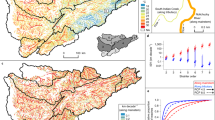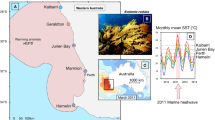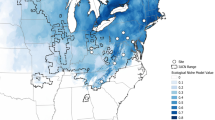Abstract
Local adaptation is assumed to occur under limited gene flow. However, habitat-matching theory predicts dispersal should favour rather than hinder local adaptation when individuals selectively disperse towards habitats maximizing their performance. We provide experimental evidence that local adaptation to the upper margin of a species’ thermal niche is favoured by dispersal with habitat choice, but hindered under random dispersal. Our study challenges the idea that high gene flow precludes local adaptation, and provides unique experimental evidence of habitat choice as an overlooked mechanism responsible for adaptation under rapid environmental changes.
This is a preview of subscription content, access via your institution
Access options
Access Nature and 54 other Nature Portfolio journals
Get Nature+, our best-value online-access subscription
$29.99 / 30 days
cancel any time
Subscribe to this journal
Receive 12 digital issues and online access to articles
$119.00 per year
only $9.92 per issue
Buy this article
- Purchase on Springer Link
- Instant access to full article PDF
Prices may be subject to local taxes which are calculated during checkout


Similar content being viewed by others
References
Kawecki, T. J. & Ebert, D. Ecol. Lett. 7, 1225–1241 (2004).
Bolnick, D. I. & Nosil, P. Evolution 61, 2229–2243 (2007).
Ronce, O. Annu. Rev. Ecol. Evol. Syst. 38, 231–253 (2007).
Holt, R. D. Evol. Ecol. 1, 331–347 (1987).
Edelaar, P., Siepielski, A. M. & Clobert, J. Evolution 62, 2462–2472 (2008).
Edelaar, P. & Bolnick, D. I. Trends Ecol. Evol. 27, 659–665 (2012).
Jacob, S., Bestion, E., Legrand, D., Clobert, J. & Cote, J. Evol. Ecol. 29, 851–871 (2015).
Rice, W. R. & Salt, G. W. Evolution 44, 1140–1152 (1990).
Bestion, E., Clobert, J. & Cote, J. Ecol. Lett. 18, 1226–1233 (2015).
Garant, D., Kruuk, L. E., Wilkin, T. A., McCleery, R. H. & Sheldon, B. C. Nature 433, 60–65 (2005).
Cote, J. et al. Ecography 40, 56–73 (2017).
Clobert, J., Le Galliard, J.-F., Cote, J., Meylan, S. & Massot, M. Ecol. Lett. 12, 197–209 (2009).
Chaine, A. S., Schtickzelle, N., Polard, T., Huet, M. & Clobert, J. Evolution 54, 1290–1300 (2010).
Jacob, S. et al. Evolution 70, 2336–2345 (2016).
Blanquart, F., Kaltz, O., Nuismer, S. L. & Gandon, S. Ecol. Lett. 16, 1195–1205 (2013).
Postma, E. & van Noordwijk, A. J. Nature 433, 65–68 (2005).
Duckworth, R. A. & Badyaev, A. V. Proc. Natl Acad. Sci. USA 104, 15017–15022 (2007).
Hendry, A. P. in Eco-evolutionary Dynamics 109–132 (Princeton Univ. Press, Princeton, NJ, 2017).
Lee, C. E. Trends Ecol. Evol. 17, 386–391 (2002).
Kolbe, J. et al. Nature 431, 177–181 (2004).
Fronhofer, E. A. & Altermatt, F. Nat. Commun. 6, 6844 (2015).
Travis, J. M. J. et al. Oikos 122, 1532–1540 (2013).
Zufall, R. A., Dimond, K. L. & Doerder F. P. Mol. Ecol. 22, 1081–1091 (2013).
Kahm, M., Hasenbrink, G., Lichtenberg-Frate, H., Ludwig, J. & Kschischo, M. J. Stat. Softw. 33, 1–21 (2010).
Acknowledgements
We thank O. Ronce for helpful comments. This study was supported by funding from the Agence Nationale de la Recherche INDHET (ANR-12-BSV7-0023) to S.J. and J.C., ANR Netselect (ANR-10-JCJC-1704) to A.S.C., and ARC (Actions de Recherche Concertées) 10-15/031, F.S.R.-FNRS (Fond National pour la Recherche Scientifique) and UCL-FSR (Université Catholique de Louvain) to S.J., D.L. and N.S. (an FNRS Research research associate). S.J. was awarded by a Move-In-Louvain Marie Curie Action fellowship. D.B., S.J. and N.S. were funded by the FWO (Research Foundation—Flanders) research community EVENET (Eco-evolutionary network of biotic interactions) and a networking grant from Université Catholique de Louvain (FEEDING). D.B. was funded by the FWO (INVADED G018017N). This work was conducted by S.J., D.L., A.S.C., M.H. and J.C as part of a project of the Laboratoire d’Excellence entitled TULIP (Toward a Unified Theory of Biotic Interactions; ANR-10-LABX-41), and contributes (BRC401) to the Biodiversity Research Centre at Université Catholique de Louvain, to which N.S. and S.J. are affiliated.
Author information
Authors and Affiliations
Contributions
S.J., D.L., A.S.C., D.B. and J.C. defined the research theme. S.J., D.L., A.S.C., D.B., M.H. and J.C. set up the experimental protocols. S.J. performed the experiments and analysed the data with the help of M.H. and N.S. S.J. wrote the manuscript. D.L., A.S.C., D.B., N.S. and J.C. contributed substantially to the revisions.
Corresponding author
Ethics declarations
Competing interests
The authors declare no competing financial interests.
Additional information
Publisher’s note: Springer Nature remains neutral with regard to jurisdictional claims in published maps and institutional affiliations.
Electronic supplementary material
Supplementary Information
Supplementary Figures, Supplementary Tables and Supplementary Material
Rights and permissions
About this article
Cite this article
Jacob, S., Legrand, D., Chaine, A.S. et al. Gene flow favours local adaptation under habitat choice in ciliate microcosms. Nat Ecol Evol 1, 1407–1410 (2017). https://doi.org/10.1038/s41559-017-0269-5
Received:
Accepted:
Published:
Issue Date:
DOI: https://doi.org/10.1038/s41559-017-0269-5
This article is cited by
-
Genetics reveals shifts in reproductive behaviour of the invasive bird parasite Philornis downsi collected from Darwin’s finch nests
Biological Invasions (2023)
-
Accurate and sensitive detection of microbial eukaryotes from whole metagenome shotgun sequencing
Microbiome (2021)
-
Genome-wide genetic diversity yields insights into genomic responses of candidate climate-selected loci in an Andean wetland plant
Scientific Reports (2020)
-
Dispersal dilemmas
Nature Ecology & Evolution (2018)
-
Bottom-up and top-down control of dispersal across major organismal groups
Nature Ecology & Evolution (2018)



